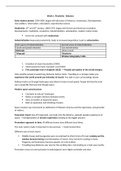Week 1: Proximity - Distance
Early modern period: 1500-1800, began with discovery of America, renaissance. Developments:
mercantilism, reformation, colonialism, experimental science.
Modernity: 19th and 20th century, 1800-1970, began with French and American revolution.
Developments: Capitalism, secularism, industrialization, urbanization, modern nation states.
Not to be confused with modernism.
Industrialization improved productivity, leads to increased population, leads to urbanization.
First waves of industrialization. Second waves of industrialization.
Canals and postal networks Gas and electricity
Railroads Urban transit
Telegraph Telephone
Wireless telegraphy/radio
1. Invention of steam locomotive (1800).
2. Steam-powered trains transport coal (1810).
3. First passenger train in England (1825). -> Peoples perception of the world changes.
Only wealthy people traveled long distances before trains. Travelling in a carriage makes you
experience the world around you (intensity of travel). You take in your surroundings slower.
Railway tracks cut through landscapes and allow for faster travel speed. People felt that the train
was a projectile that was shot though space.
Modern space consciousness:
Contrasts to natural ‘landscape’.
Relies on straight, flat lines between points.
Aims at masters of expansive space.
Both an expansion and shrinking of space.
Space mastery was instrument to settlement of Western America and the oppression and genocide
of natives.
Panoramic travel: loss of foreground, one looks into the distance, expands peoples experience of
space. -> Reorganization of sensory experience (looking at the bigger picture).
Premodern approach to time: All different towns have different local times.
The train system made it important to be punctual. -> Synchronized time.
Different uses of train travel:
Middle classes and bourgeoisie were accustomed to other forms of travel. Looking out the
window became boring (overstimulation of vision). They turned to reading in trains.
Magazine and bookstores became popular on train stations.
Travelling long distances was new for the working class. Commuting on a train was novelty.
Premodern ways of communication (smoke/pigeon) were highly unreliable and slow.
,Industrialization and the new energy resources (from wood, wind and water to iron, coal and steam)
allow the development of new communication technologies
Telecommunication:
1. Message transmission point-to-point.
2. Sending message without physical transportation.
3. Interaction: people/institutions can easily reply.
Telegraph (distant writing) was used by Napoleon for wartime communication (1790).
The electrical telegraph (morse code) was established in 1830`s.
Europe regulated telegraphy by state. This made business investors cautious (slower development)
but enables an international communications network.
The US privatized telegraphy. More focused on private businesses. National communication.
Telegraphy:
Military use
International stock market
Railway networks
Private communication
Changes in journalism
o Better access to news, acceleration of news, organization of press agencies.
Telephony (distance, sound):
First domestic (home) telecommunication media.
Three main business models:
o Public monopoly
o Private business
o Mixed system
Different uses: commercial versus private.
The invention of radio was unexpected because there was already a medium that transmitted
sound, the telephone. This shows that paths of development are not pre-determined. New media
are always introduced in negotiation with existing paths of development.
Telecommunication media
Increased places that a person can reach.
Faster and easier to use than previous technology.
Increased access.
Changed experience of space and time.
Made possible the organization of complex societies.
Supported projects of political, economic and social globalization.
, Week 2: Still – Moving
Camera obscura: Dark box camera. The light that falls through the hole creates an image.
Magic lantern: Projects image through lens.
Both could not be permanent (like a photo).
Niépce created the first photograph (1827), based on the reaction of chemicals to light.
There is a direct connection between a photo and the object it represents (light). This is the
indexicality (direct relation and meaning) of photography.
Daguerrotype, invented in 1838, named after Louis-Jacques-Mandé Daguerre: negative photograph,
development, fixation.
The exposure time got smaller creating the opportunity for different kinds of photos.
Photography (light write) and its indexicality:
Truthful: it’s not made by humans (like a painting) but by an apparatus (used for
documenting).
A fixing of time (new for people): creating moments of the past.
Improved access to the world: people thought that photos could capture spirits.
Commodity: it was affordable for most people.
Detailed/realistic: people found their portraits too detailed, thus inventing soft focus.
Management of growing societies: It was used to identify people.
Composite photography: layering portraits to get a typical profile (criminals for example).
Stilling movement: photographs were used to still and study movement (animals).
o Zoopraxiscope (Edward Muybridge): a device of multiple cameras to photograph
the movement of animals for analyzation.
o Photographic gun (1882, Étienne-Jules Marey): an apparatus (gun) that could take
multiple photos
Zoetrope (wheel of life): first animation due to speed and rapid intermittent succession. These are
necessary to create the illusion of movement.
Celluloid was invented in the 1880`s. This was a necessity for cinema.
Cinema was invented by multiple scientists across the US and Europe (peepshow and projectors):
Kinetoscope (Edison, USA): peepshow device
Cinématographe (Lumiére, France): camera, printer and part of projector.
Bioscop (Skladanowsky, Germany)
Phantomscope (Jenskin and Armat, USA)
Mutoscope (Castler, USA)
December 1895, there was a projection at the Grand Café. This is the year that cinema was invented.
Steps of media development:
1. The appearance of a technological process;
2. The emergence of an apparatus;
3. The constitution of a media institution.




